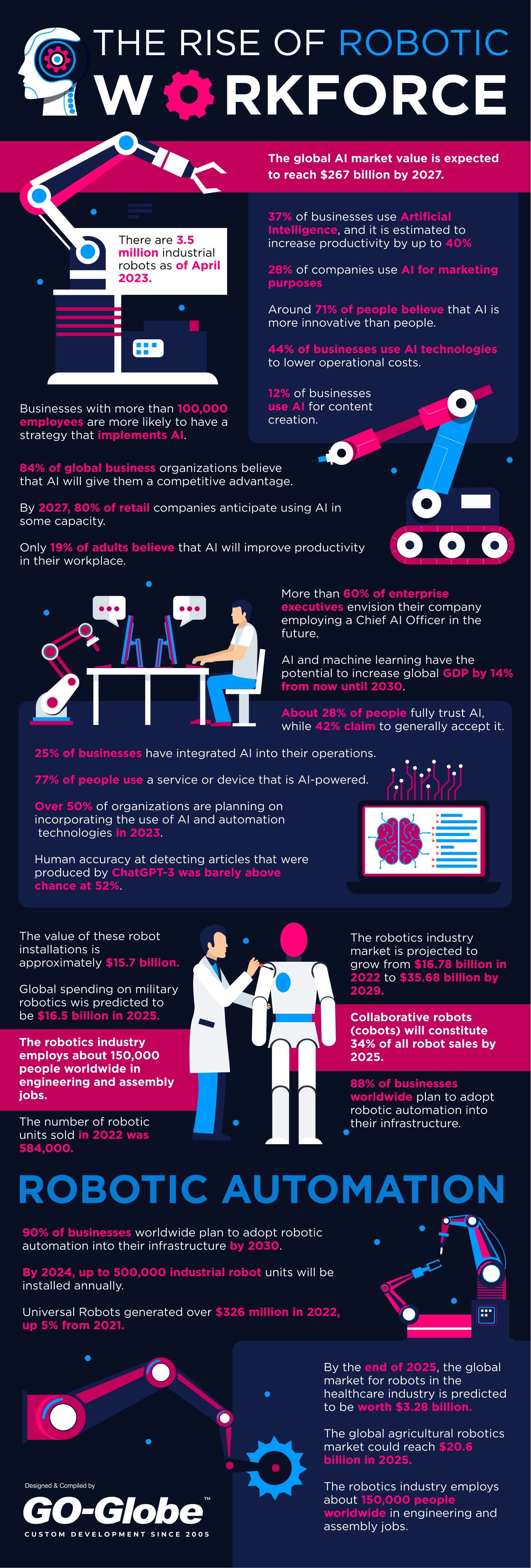Contents
- 1 The Impact of Robotic Workforce and AI Automation in Industries
- 2 What is a Robotic Workforce?
- 3 Advantages of Robotic Workforce and AI Automation
- 4 Applications of Robotic Workforce and AI Across Industries
- 5 Challenges of Robotic Workforce and AI Automation
- 6 The Future of AI and Automation in the Workforce
- 7 Conclusion
- 8 FAQs (Frequently Asked Questions)
- 9 The Rise of Robotic Workforce: Industries Embracing AI Automation
The Impact of Robotic Workforce and AI Automation in Industries
The integration of robotic workforce and AI automation has revolutionized industries by streamlining processes, increasing efficiency, and reducing costs. These technologies have become pivotal in reshaping how businesses operate, offering immense potential for growth and innovation. However, as industries embrace these advancements, challenges such as robotic workforce problems and ethical concerns arise. In this article, we will explore the role, benefits, and challenges of AI in automation industry , as well as the future of AI and automation in the workforce.
What is a Robotic Workforce?
A robotic workforce refers to intelligent machines designed to perform tasks autonomously or with minimal human intervention. These robots are equipped with advanced technologies, including sensors, machine learning algorithms, and computer vision, enabling them to execute complex operations efficiently. From manufacturing to healthcare, the robotic workforce plays a crucial role in automating repetitive tasks and improving productivity.
How Does AI Contribute to Industrial Automation?
Artificial Intelligence (AI) enhances industrial automation by enabling machines to simulate human intelligence. AI systems can analyze vast amounts of data, learn from patterns, and make intelligent decisions. This capability allows industries to optimize processes, predict maintenance needs, and improve overall operational efficiency. For instance, AI automation Calgary has been instrumental in transforming local industries by leveraging smart technologies to streamline workflows.
Advantages of Robotic Workforce and AI Automation
1. Increased Efficiency and Productivity
By integrating a robotic workforce and AI for enterprise, industries can achieve unparalleled levels of efficiency and productivity. Robots perform tasks with precision, speed, and consistency, eliminating human errors and reducing cycle times. AI-powered analytics further enhance productivity by providing actionable insights for process optimization.
2. Enhanced Safety for Employees
One of the most significant benefits of a robotic workforce is improved workplace safety. Dangerous and physically demanding tasks can be delegated to robots, protecting human workers from harm. AI systems also monitor environments for anomalies, preventing accidents and ensuring compliance with safety standards.
3. Cost Savings
Applications of Robotic Workforce and AI Across Industries
Manufacturing
The manufacturing sector has embraced robotic workforce and AI to streamline production lines. Robots handle assembly, quality control, and material handling, while AI systems analyze data for predictive maintenance and equipment optimization. This combination enhances manufacturing speed, accuracy, and overall equipment effectiveness.
Healthcare
In healthcare, AI automation has transformed diagnostics, surgical procedures, and patient care. Surgical robots assist doctors with unparalleled precision, reducing invasiveness and recovery times. AI algorithms analyze medical data to aid in disease diagnosis, drug discovery, and personalized treatment plans.
Logistics and Warehousing
The logistics and warehousing industry benefits significantly from AI automation Calgary innovations. Autonomous drones and robots manage inventory, pick orders, and sort packages, reducing errors and speeding up fulfillment. AI-powered route planning optimizes delivery schedules, improving efficiency.
Agriculture
Robotic workforce solutions address labor shortages and increase crop yields in agriculture. Autonomous robots perform tasks like seeding, fertilizing, and harvesting with precision. AI monitors crop health, optimizes irrigation, and detects diseases, promoting sustainable farming practices.
Construction
In construction, robots perform repetitive tasks such as bricklaying, concrete pouring, and welding. AI aids in project planning, cost estimation, and quality control, ensuring timely and efficient project completion.
Challenges of Robotic Workforce and AI Automation
1. Robotic Workforce Problems: Job Displacement and Transformation
One of the primary robotic workforce problems is the potential for job displacement. As machines take over repetitive tasks, some roles traditionally performed by humans may become obsolete. However, this shift also creates opportunities for workers to upskill and transition into higher-value roles that require creativity, problem-solving, and emotional intelligence.
2. Ethical Concerns in AI Automation
As AI systems become more autonomous, ethical considerations arise. Issues such as accountability, privacy, and algorithmic bias must be addressed to ensure responsible and fair use of these technologies. Transparency in decision-making processes is critical to maintaining trust and integrity.
3. Technical Limitations
Despite advancements, robotic workforce and AI automation face technical limitations. Factors such as sensor accuracy, adaptability to complex environments, and handling unstructured data pose challenges for seamless integration and performance optimization.
The Future of AI and Automation in the Workforce
The future of AI and automation in the workforce is promising. Innovations in machine learning, computer vision, and natural language processing will enhance the capabilities of robots and AI systems. Increased collaboration between humans and machines will lead to new applications, improved efficiency, and innovative solutions across industries.
For example, AI automation Calgary is expected to drive further economic growth by fostering technological advancements and creating high-value jobs. As industries continue to adopt these technologies, addressing robotic workforce problems and ethical concerns will be crucial for sustainable progress.
Conclusion
The integration of robotic workforce and AI in automation industry has transformed industries by boosting efficiency, enhancing safety, and reducing costs. While challenges such as robotic workforce problems and ethical considerations exist, responsible adoption and continuous innovation will pave the way for a successful future. As the world moves toward a more automated and intelligent workforce, embracing these technologies will be key to staying competitive and driving growth.
FAQs (Frequently Asked Questions)
Q: What is the role of a robotic workforce in industries?
A: A robotic workforce automates tasks, improves efficiency, and enhances productivity across industries such as manufacturing, healthcare, logistics, and agriculture.
Q: How does AI contribute to industrial automation?
A: AI enables machines to simulate human intelligence, analyze data, and make intelligent decisions, optimizing processes and improving decision-making in industrial automation.
Q: What are the potential benefits of AI automation in manufacturing?
A: AI automation in manufacturing increases production speed, improves quality control, reduces costs, and enables predictive maintenance through data analysis.
Q: Are there any ethical concerns with robotic workforce and AI?
A: Yes, ethical concerns include accountability, privacy, and algorithmic bias. Addressing these issues is essential for responsible and fair use of robotic workforce and AI technologies.
Q: What does the future hold for AI and automation in the workforce?
A: The future of AI and automation in the workforce is bright, with advancements in technology leading to more capable systems, innovative applications, and increased collaboration between humans and machines.

Infographics by GO-Globe Web Design Dubai
The Rise of Robotic Workforce: Industries Embracing AI Automation
- 37% of businesses use Artificial Intelligence, and it is estimated to increase productivity by up to 40%
- The global AI market value is expected to reach $267 billion by 2027.
- 28% of companies use AI for marketing purposes
- Around 71% of people believe that AI is more innovative than people.
- 44% of businesses use AI technologies to lower operational costs.
- Businesses with more than 100,000 employees are more likely to have a strategy that implements AI.
- 12% of businesses use AI for content creation.
- 84% of global business organizations believe that AI will give them a competitive advantage.
- By 2027, 80% of retail companies anticipate using AI in some capacity.
- Only 19% of adults believe that AI will improve productivity in their workplace.
- More than 60% of enterprise executives envision their company employing a Chief AI Officer in the future.
- AI and machine learning have the potential to increase global GDP by 14% from now until 2030.
- About 28% of people fully trust AI, while 42% claim to generally accept it.
- 25% of businesses have integrated AI into their operations.
- 77% of people use a service or device that is AI-powered.
- Over 50% of organizations are planning on incorporating the use of AI and automation technologies in 2023.
- Human accuracy at detecting articles that were produced by ChatGPT-3 was barely above chance at 52%.
- There are 3.5 million industrial robots as of April 2023.
- The value of these robot installations is approximately $15.7 billion.
- Global spending on military robotics wis predicted to be $16.5 billion in 2025.
- The robotics industry employs about 150,000 people worldwide in engineering and assembly jobs.
- The number of robotic units sold in 2022 was 584,000.
- The robotics industry market is projected to grow from $16.78 billion in 2022 to $35.68 billion by 2029.
- Collaborative robots (cobots) will constitute 34% of all robot sales by 2025.
- 88% of businesses worldwide plan to adopt robotic automation into their infrastructure.
- 90% of businesses worldwide plan to adopt robotic automation into their infrastructure by 2030.
- By 2024, up to 500,000 industrial robot units will be installed annually.
- Universal Robots generated over $326 million in 2022, up 5% from 2021.
- By the end of 2025, the global market for robots in the healthcare industry is predicted to be worth $3.28 billion.
- The global agricultural robotics market could reach $20.6 billion in 2025.
- The robotics industry employs about 150,000 people worldwide in engineering and assembly jobs.

















